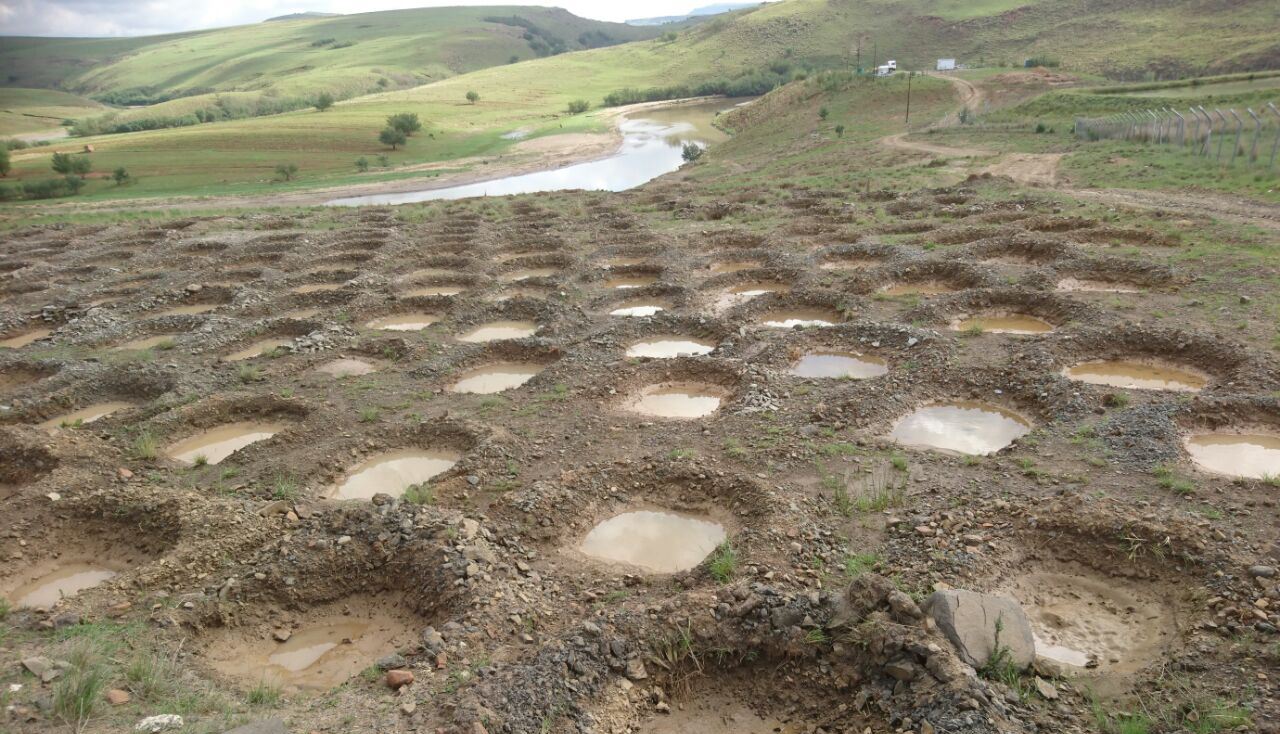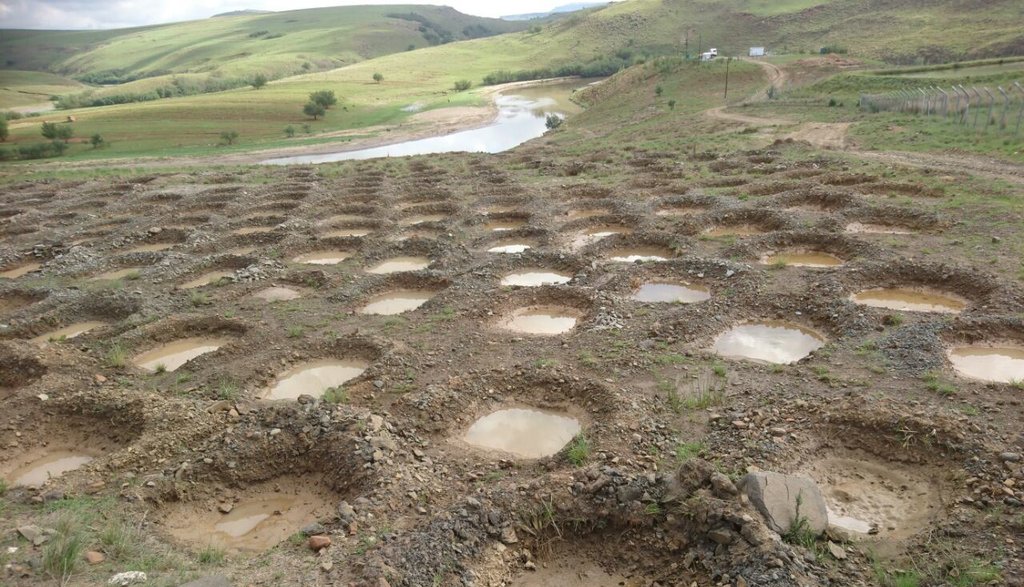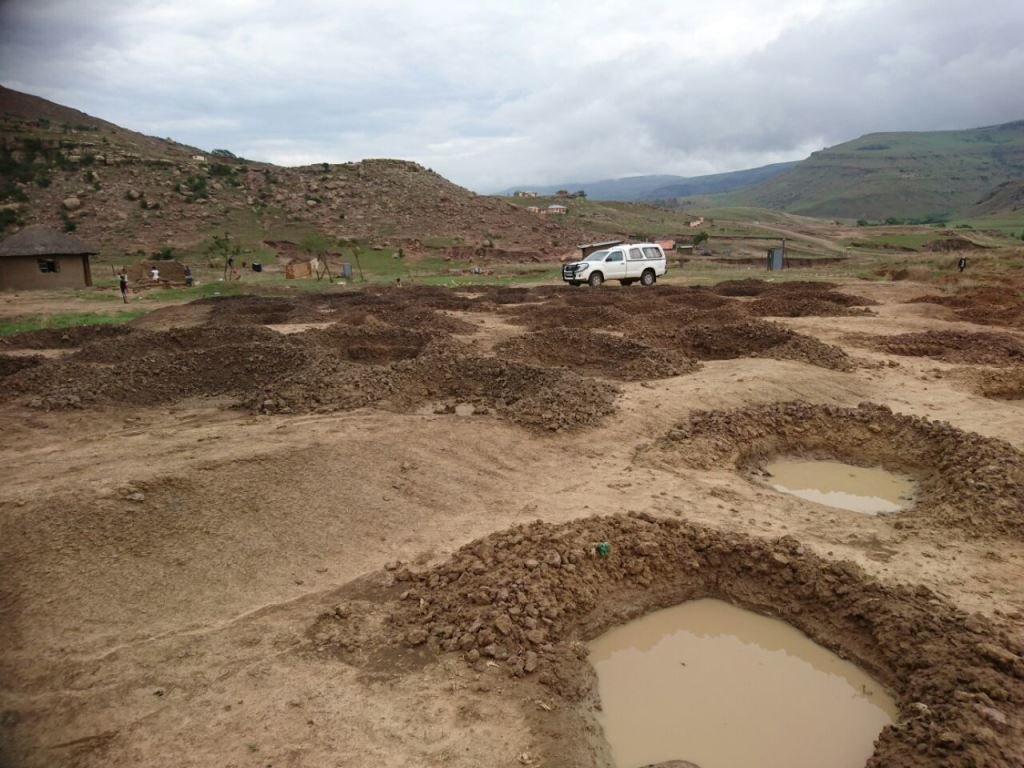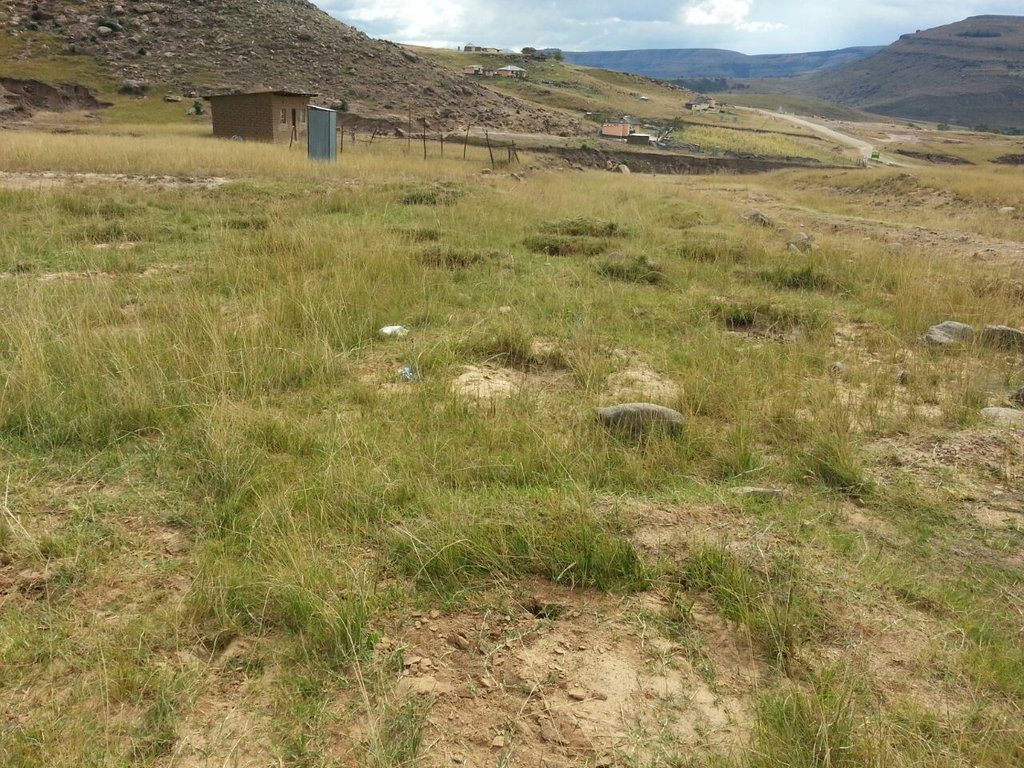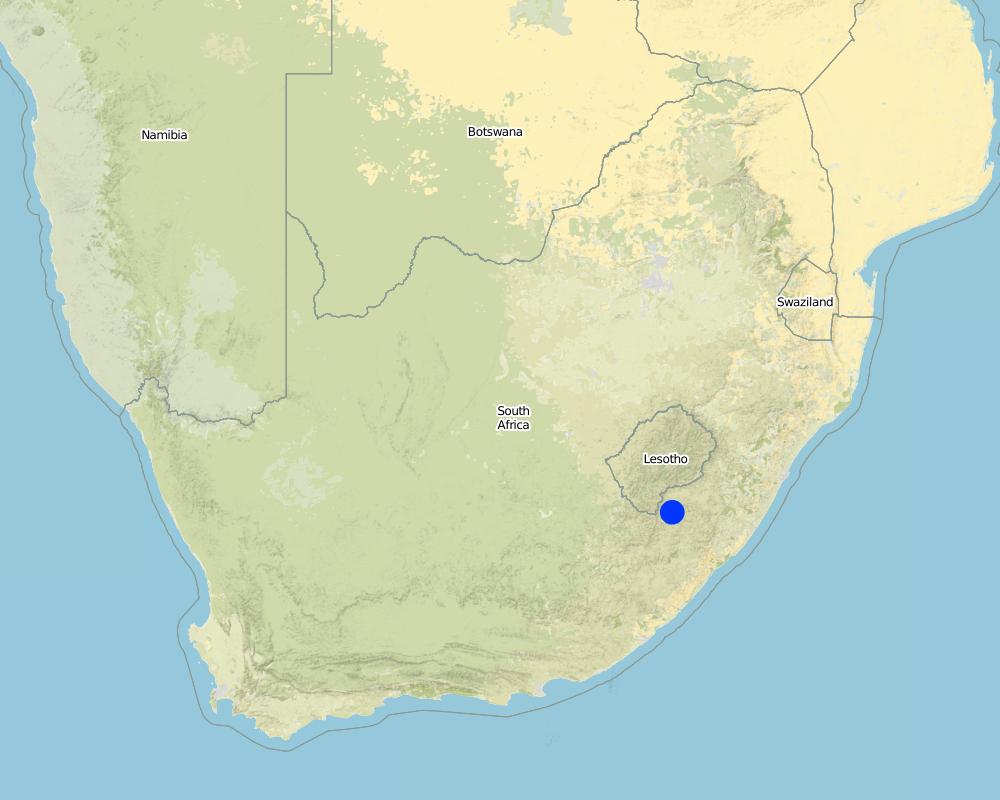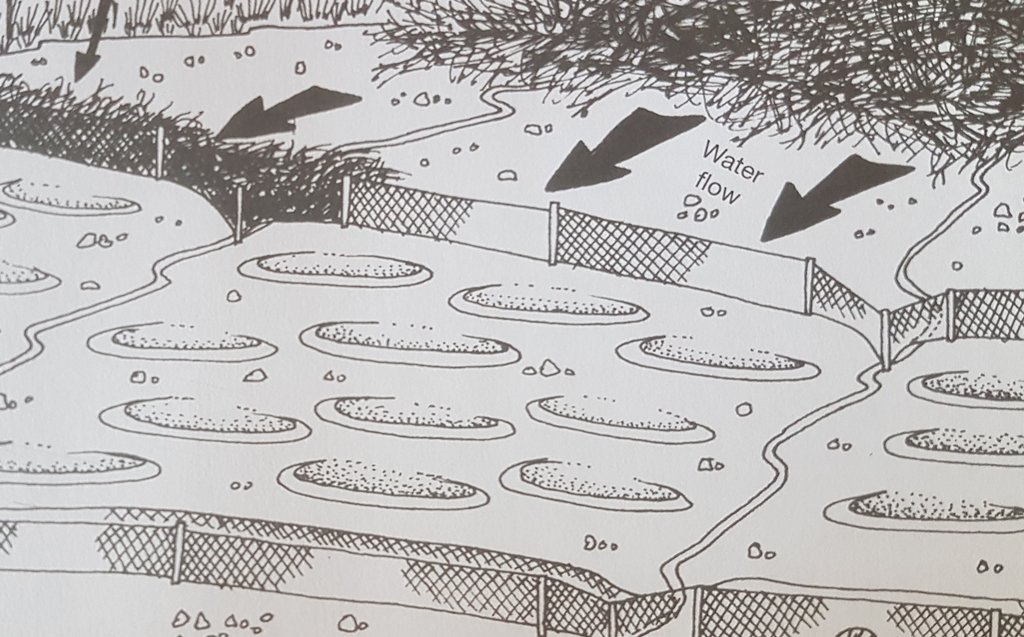Pitting to restore degraded catchment of Mount Fletcher Dam [South Africa]
- Creation:
- Update:
- Compiler: Dirk Pretorius
- Editor: –
- Reviewer: Rima Mekdaschi Studer
Pits
technologies_3377 - South Africa
- Full summary as PDF
- Full summary as PDF for print
- Full summary in the browser
- Full summary (unformatted)
- Pitting to restore degraded catchment of Mount Fletcher Dam : March 21, 2018 (inactive)
- Pitting to restore degraded catchment of Mount Fletcher Dam : April 20, 2018 (inactive)
- Pitting to restore degraded catchment of Mount Fletcher Dam: June 20, 2019 (inactive)
- Pitting to restore degraded catchment of Mount Fletcher Dam: Nov. 2, 2021 (public)
View sections
Expand all Collapse all1. General information
1.2 Contact details of resource persons and institutions involved in the assessment and documentation of the Technology
Key resource person(s)
SLM specialist:
Buckle Jacob
+27 082 8207083
JBuckle@environment.gov.za
Department of Environmental Affairs - South Africa
14 Loop Street, Cape Town, 8000
South Africa
Name of project which facilitated the documentation/ evaluation of the Technology (if relevant)
Working on Ecosystems (Natural Resource Management Programmes – DEA, South Africa)Name of the institution(s) which facilitated the documentation/ evaluation of the Technology (if relevant)
SMC Synergy (SMC Synergy) - South Africa1.3 Conditions regarding the use of data documented through WOCAT
When were the data compiled (in the field)?
18/01/2018
The compiler and key resource person(s) accept the conditions regarding the use of data documented through WOCAT:
Yes
1.4 Declaration on sustainability of the described Technology
Is the Technology described here problematic with regard to land degradation, so that it cannot be declared a sustainable land management technology?
No
1.5 Reference to Questionnaire(s) on SLM Approaches
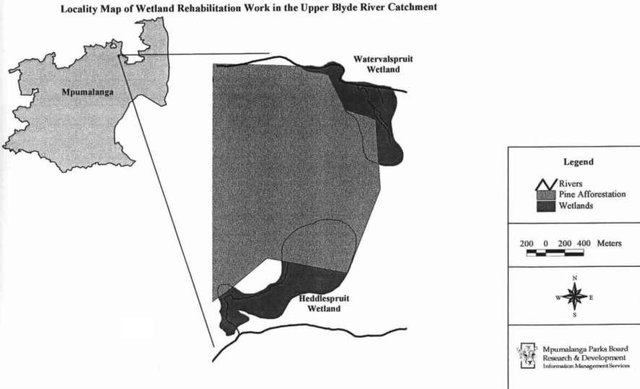
Working for Water Wetland rehabilitation [South Africa]
To improve the quality & quantity of water production and biodiversity in the Blyde River catchment area.
- Compiler: Unknown User
2. Description of the SLM Technology
2.1 Short description of the Technology
Definition of the Technology:
To improve infiltration and vegetation cover, by creating small pits on bare soil, which capture runoff and reduce erosion.
2.2 Detailed description of the Technology
Description:
This project on pitting was implemented on the banks of the Mount Fletcher dam in the Eastern Cape of South Africa. The rehabilitation was funded by the Department of Environmental Affairs as part of the “Working on Ecosystems” programme. The programme also focuses on creating jobs and improving skill levels within local communities. The average annual rainfall in the area is 600 to 800 mm and occurs mainly in summer as thunderstorms. Severe sheet and rill erosion occur in the dam’s catchment. Combined with overgrazing and veld fires on the highly erodible soils, the catchment is severely degraded. Due to the degradation, high loads of sediment have resulted in severe siltation of the Mount Fletcher dam. The pitting technology can help. It is suitable for any low gradient, degraded, landscape as long as duplex soils are not present - due to piping on these soils. The main purpose of pitting is to enhance infiltration of runoff water by capturing, and ponding, it on capped/crusted bare soils. Simultaneously soil loss, due to sheet and rill erosion, is reduced. Secondary benefits of ponding runoff include trapping of sediment and subsequent improvement of vegetation cover. Pitting is combined with brush packing (laying cut bush on the soil’s surface) or mulching, and the construction of silt fences (low barriers across the slope) to further improve sediment trapping. This technology commences with the digging of small pits (70 cm surface diameter and 30 cm deep ) by hand or mechanical implements. The excavated soil is piled up to form a ridge on the down-slope. Pits are placed 2 meters apart in rows 1 meter apart. Re-seeding in pits with commercially available grass seed mixes can be used to enhance vegetation cover. Brush packing over the ponds with local woody (preferably thorny branches) material is recommended (if available locally) to provide protection against grazing and to create a micro-climate for vegetation growth. In between and above the pits silt fences or fiber rolls (can be used to slow water runoff (placed 10 m apart, across the slope). Maintenance of the structures will include the creation of more pits and repair of silt fences and/or fiber rolls where needed. Further brush packing might be required after 6 months.
2.3 Photos of the Technology
2.5 Country/ region/ locations where the Technology has been applied and which are covered by this assessment
Country:
South Africa
Region/ State/ Province:
Eastern Cape
Further specification of location:
Near the town of Mount Fletcher on the banks of the Mount Fletcher dam
Map
×2.6 Date of implementation
Indicate year of implementation:
2016
2.7 Introduction of the Technology
Specify how the Technology was introduced:
- through projects/ external interventions
3. Classification of the SLM Technology
3.1 Main purpose(s) of the Technology
- improve production
- reduce, prevent, restore land degradation
- conserve ecosystem
- protect a watershed/ downstream areas – in combination with other Technologies
- reduce risk of disasters
- create beneficial economic impact
3.2 Current land use type(s) where the Technology is applied

Grazing land
Extensive grazing land:
- Semi-nomadism/ pastoralism
Main animal species and products:
Cattle, goats and sheep - meat and milk
3.3 Further information about land use
Water supply for the land on which the Technology is applied:
- rainfed
Number of growing seasons per year:
- 1
Livestock density (if relevant):
Low
3.4 SLM group to which the Technology belongs
- pastoralism and grazing land management
- improved ground/ vegetation cover
- surface water management (spring, river, lakes, sea)
3.5 Spread of the Technology
Specify the spread of the Technology:
- evenly spread over an area
If the Technology is evenly spread over an area, indicate approximate area covered:
- 0.1-1 km2
3.6 SLM measures comprising the Technology

vegetative measures
- V2: Grasses and perennial herbaceous plants

structural measures
- S4: Level ditches, pits
- S11: Others

management measures
- M2: Change of management/ intensity level
Comments:
Other structural measures include brush packing (or mulch if available) and the placement of silt fences
3.7 Main types of land degradation addressed by the Technology

soil erosion by water
- Wt: loss of topsoil/ surface erosion
- Wo: offsite degradation effects

physical soil deterioration
- Pk: slaking and crusting
3.8 Prevention, reduction, or restoration of land degradation
Specify the goal of the Technology with regard to land degradation:
- reduce land degradation
- restore/ rehabilitate severely degraded land
4. Technical specifications, implementation activities, inputs, and costs
4.1 Technical drawing of the Technology
4.2 Technical specifications/ explanations of technical drawing
Pitting can be used to restore degraded bare landscapes on slopes up to 30 percent, though not on highly erodible duplex soils. The pits are dug 30 cm deep, with a surface diameter of 70 cm, and sited 2 m apart in rows 1 meter apart. Silt fences or fiber rolls are located 10 m apart across the slope. Brush packing is recommended for protection.
4.3 General information regarding the calculation of inputs and costs
Specify how costs and inputs were calculated:
- per Technology area
Indicate size and area unit:
2 hectares
other/ national currency (specify):
Rand
Indicate exchange rate from USD to local currency (if relevant): 1 USD =:
12.0
Indicate average wage cost of hired labour per day:
140 (excluding transport)
4.4 Establishment activities
| Activity | Type of measure | Timing | |
|---|---|---|---|
| 1. | Dig pits (2500/ha) | Structural | 2 to 3 months before onset of summer rains |
| 2. | Install silt fences or fibre rolls | Structural | 2 to 3 months before onset of summer rains |
| 3. | Add grass seed mix in ponds and cover with layer of soil | Vegetative | 2 to 3 months before onset of summer rains |
| 4. | Brush packing between pits | Structural | 2 to 3 months before onset of summer rains |
4.5 Costs and inputs needed for establishment
| Specify input | Unit | Quantity | Costs per Unit | Total costs per input | % of costs borne by land users | |
|---|---|---|---|---|---|---|
| Labour | Unskilled labour (including transport) | per day | 160.0 | 240.0 | 38400.0 | |
| Equipment | Picks, spades, hand compactor, pliers, hopper, bow saws, hammer, wheel barrow (renting the equipment) | per day | 14.0 | 20.0 | 280.0 | |
| Plant material | Grass seed | kilogram | 2.0 | 75.0 | 150.0 | |
| Construction material | Silt fences or fibre rolls | per meter | 2000.0 | 15.0 | 30000.0 | |
| Construction material | 1.0 | |||||
| Total costs for establishment of the Technology | 68830.0 | |||||
If land user bore less than 100% of costs, indicate who covered the remaining costs:
Department of Environmental Affairs - South Africa
4.6 Maintenance/ recurrent activities
| Activity | Type of measure | Timing/ frequency | |
|---|---|---|---|
| 1. | Add more ponds if necessary | Structural | After floods |
| 2. | Restore silt fences | Structural | After floods |
| 3. | Brush packing of ponds | Structural | After 6 months |
4.7 Costs and inputs needed for maintenance/ recurrent activities (per year)
| Specify input | Unit | Quantity | Costs per Unit | Total costs per input | % of costs borne by land users | |
|---|---|---|---|---|---|---|
| Labour | Unskilled labour | per day | 6.0 | 240.0 | 1440.0 | |
| Equipment | Picks, spades, hand compactor, pliers, hopper, bow saws, hammer, wheel barrow (renting the equipment) | per day | 6.0 | 20.0 | 120.0 | |
| Plant material | Grass seed | kilogram | 0.5 | 75.0 | 37.5 | |
| Construction material | Silt fences | per meter | 200.0 | 15.0 | 3000.0 | |
| Total costs for maintenance of the Technology | 4597.5 | |||||
If land user bore less than 100% of costs, indicate who covered the remaining costs:
Department of Environmental Affairs - South Africa
4.8 Most important factors affecting the costs
Describe the most determinate factors affecting the costs:
Labor availability, soil hardness, availability of material, transport cost.
5. Natural and human environment
5.1 Climate
Annual rainfall
- < 250 mm
- 251-500 mm
- 501-750 mm
- 751-1,000 mm
- 1,001-1,500 mm
- 1,501-2,000 mm
- 2,001-3,000 mm
- 3,001-4,000 mm
- > 4,000 mm
Specify average annual rainfall (if known), in mm:
750.00
Specifications/ comments on rainfall:
Summer thunderstorms
Agro-climatic zone
- semi-arid
5.2 Topography
Slopes on average:
- flat (0-2%)
- gentle (3-5%)
- moderate (6-10%)
- rolling (11-15%)
- hilly (16-30%)
- steep (31-60%)
- very steep (>60%)
Landforms:
- plateau/plains
- ridges
- mountain slopes
- hill slopes
- footslopes
- valley floors
Altitudinal zone:
- 0-100 m a.s.l.
- 101-500 m a.s.l.
- 501-1,000 m a.s.l.
- 1,001-1,500 m a.s.l.
- 1,501-2,000 m a.s.l.
- 2,001-2,500 m a.s.l.
- 2,501-3,000 m a.s.l.
- 3,001-4,000 m a.s.l.
- > 4,000 m a.s.l.
Indicate if the Technology is specifically applied in:
- concave situations
5.3 Soils
Soil depth on average:
- very shallow (0-20 cm)
- shallow (21-50 cm)
- moderately deep (51-80 cm)
- deep (81-120 cm)
- very deep (> 120 cm)
Soil texture (topsoil):
- medium (loamy, silty)
Soil texture (> 20 cm below surface):
- medium (loamy, silty)
Topsoil organic matter:
- low (<1%)
5.4 Water availability and quality
Ground water table:
< 5 m
Availability of surface water:
poor/ none
Water quality (untreated):
unusable
Is water salinity a problem?
No
Is flooding of the area occurring?
Yes
Regularity:
episodically
Comments and further specifications on water quality and quantity:
Steep slopes in the catchment with frequent high rainfall events contribute to high levels of sheet and rill erosion casing the siltation of the Mount Fletcher dam (affecting the usability of the water and storing capacity of the dam).
5.5 Biodiversity
Species diversity:
- low
Habitat diversity:
- low
Comments and further specifications on biodiversity:
Degraded grassland
5.6 Characteristics of land users applying the Technology
Sedentary or nomadic:
- Sedentary
Market orientation of production system:
- subsistence (self-supply)
Off-farm income:
- less than 10% of all income
Relative level of wealth:
- very poor
Individuals or groups:
- groups/ community
Level of mechanization:
- manual work
- animal traction
Gender:
- women
- men
Age of land users:
- middle-aged
- elderly
Indicate other relevant characteristics of the land users:
Poor rural communities far from markets - very little goods and services
5.7 Average area of land owned or leased by land users applying the Technology
- < 0.5 ha
- 0.5-1 ha
- 1-2 ha
- 2-5 ha
- 5-15 ha
- 15-50 ha
- 50-100 ha
- 100-500 ha
- 500-1,000 ha
- 1,000-10,000 ha
- > 10,000 ha
Is this considered small-, medium- or large-scale (referring to local context)?
- medium-scale
5.8 Land ownership, land use rights, and water use rights
Land ownership:
- communal/ village
Land use rights:
- communal (organized)
Water use rights:
- communal (organized)
5.9 Access to services and infrastructure
health:
- poor
- moderate
- good
education:
- poor
- moderate
- good
technical assistance:
- poor
- moderate
- good
employment (e.g. off-farm):
- poor
- moderate
- good
markets:
- poor
- moderate
- good
energy:
- poor
- moderate
- good
roads and transport:
- poor
- moderate
- good
drinking water and sanitation:
- poor
- moderate
- good
financial services:
- poor
- moderate
- good
6. Impacts and concluding statements
6.1 On-site impacts the Technology has shown
Socio-economic impacts
Production
fodder production
fodder quality
animal production
Comments/ specify:
Initially, animals are not grazed on restored areas to allow vegetation recovery – but the long term impacts should be positive.
land management
Comments/ specify:
Brush packing is used to prevent animals from grazing on rehabilitated areas.
Water availability and quality
drinking water availability
Comments/ specify:
Infiltration improves - less runoff
drinking water quality
Comments/ specify:
Less sedimentation from runoff.
water availability for livestock
Comments/ specify:
Infiltration improves - less runoff
Income and costs
farm income
Comments/ specify:
Over the long-term farm income will increase - improved rangelands.
diversity of income sources
Comments/ specify:
Jobs are created for community members.
Other socio-economic impacts
Job creation
Improved skills
Socio-cultural impacts
food security/ self-sufficiency
SLM/ land degradation knowledge
Comments/ specify:
Skill levels increased for some community members.
situation of socially and economically disadvantaged groups
Comments/ specify:
Household income increased for some community members.
Ecological impacts
Water cycle/ runoff
water quantity
Comments/ specify:
Less runoff
water quality
Comments/ specify:
Less sedimentation from runoff.
surface runoff
Soil
soil moisture
soil cover
soil loss
soil accumulation
soil crusting/ sealing
soil organic matter/ below ground C
Biodiversity: vegetation, animals
Vegetation cover
biomass/ above ground C
plant diversity
Comments/ specify:
Improved species composition due to seeding in pits.
Climate and disaster risk reduction
flood impacts
Comments/ specify:
Less runoff
fire risk
Comments/ specify:
More biomass to burn (including fencing and fibre rolls)
micro-climate
Comments/ specify:
Improved micro-climate due to brush packing
6.2 Off-site impacts the Technology has shown
water availability
Comments/ specify:
Impact only slightly positive due to the extent of the erosion problem in the catchment - more pitting necessary to have a larger impact on the Mount Fletcher dam.
downstream siltation
Comments/ specify:
Impact only slightly positive due to the extent of the erosion problem in the catchment - more pitting necessary to have a larger impact on the Mount Fletcher dam.
Comments regarding impact assessment:
Impact of ponding only slightly positive due the the extent of the erosion problem in the catchment - more ponding necessary to have a larger impact on the Mount Fletcher dam. The Mount Fletcher dam is currently severely silted and the off-site effects of ponding is difficult to quantify at this stage.
6.3 Exposure and sensitivity of the Technology to gradual climate change and climate-related extremes/ disasters (as perceived by land users)
Gradual climate change
Gradual climate change
| Season | Type of climatic change/ extreme | How does the Technology cope with it? | |
|---|---|---|---|
| annual temperature | increase | well |
Climate-related extremes (disasters)
Meteorological disasters
| How does the Technology cope with it? | |
|---|---|
| local thunderstorm | moderately |
Climatological disasters
| How does the Technology cope with it? | |
|---|---|
| drought | not well |
| land fire | not well |
Hydrological disasters
| How does the Technology cope with it? | |
|---|---|
| flash flood | not well |
6.4 Cost-benefit analysis
How do the benefits compare with the establishment costs (from land users’ perspective)?
Short-term returns:
slightly negative
Long-term returns:
slightly positive
How do the benefits compare with the maintenance/ recurrent costs (from land users' perspective)?
Short-term returns:
slightly negative
Long-term returns:
slightly positive
6.5 Adoption of the Technology
- 10-50%
Of all those who have adopted the Technology, how many have did so spontaneously, i.e. without receiving any material incentives/ payments?
- 0-10%
6.6 Adaptation
Has the Technology been modified recently to adapt to changing conditions?
Yes
other (specify):
droughts
Specify adaptation of the Technology (design, material/ species, etc.):
Adapted grass seed mixes to be more drought tolerant
6.7 Strengths/ advantages/ opportunities of the Technology
| Strengths/ advantages/ opportunities in the land user’s view |
|---|
| Cost effective technology that can be applied to large areas. |
| Improve infiltration of runoff. |
| Improve vegetation cover and therefore productivity of livestock. |
| Help to reduce the poverty level of communities and improve skill levels. |
| Strengths/ advantages/ opportunities in the compiler’s or other key resource person’s view |
|---|
| Cost effective technology that can be applied to large areas. |
| Improve infiltration of runoff. |
| Improve vegetation cover and therefore productivity of livestock. |
| Help to reduce the poverty level of communities and improve skill levels. |
6.8 Weaknesses/ disadvantages/ risks of the Technology and ways of overcoming them
| Weaknesses/ disadvantages/ risks in the land user’s view | How can they be overcome? |
|---|---|
| Silt fences can be damaged by fire and vandalism. | Fire breaks and community engagement. |
| Very little local woody material for brush packing. | Replace brush packing with mulch from nearby areas (can be expensive due to transport). |
| Weaknesses/ disadvantages/ risks in the compiler’s or other key resource person’s view | How can they be overcome? |
|---|---|
| Silt fences can be damaged by fire and vandalism. | Fire breaks and community engagement. |
| Very little local woody material for brush packing. | Replace brush packing with mulch from nearby areas (can be expensive due to transport). |
7. References and links
7.1 Methods/ sources of information
- interviews with SLM specialists/ experts
7.2 References to available publications
Title, author, year, ISBN:
Wetland Rehabilitation Guidelines, W Russel, 2009, ISBN 978-1-77005-640-4: Water Research Commission - South Africa - WRC report TT 341/09
Available from where? Costs?
Water Research Commission - South Africa
Title, author, year, ISBN:
Caring for Natural Rangelands, Ken Coetzee, 2005, ISBN 1-86914-071-0
Available from where? Costs?
Ken Coetzee, University of KwaZulu-Natal Press
Links and modules
Expand all Collapse allLinks

Working for Water Wetland rehabilitation [South Africa]
To improve the quality & quantity of water production and biodiversity in the Blyde River catchment area.
- Compiler: Unknown User
Modules
No modules


